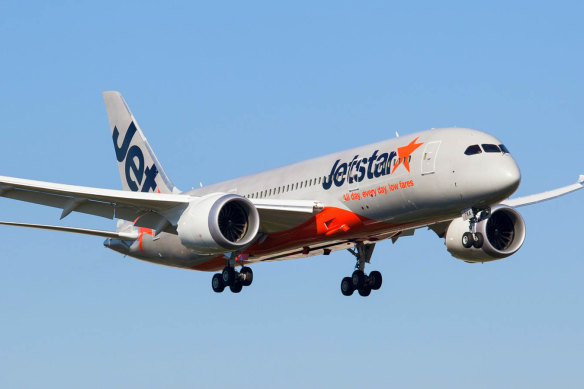A Jetstar Boeing 787 will be out of service for up to two months after a lightning strike inflicted significant damage on the jet during a flight from Melbourne to the Gold Coast earlier this month.
Images obtained by this masthead show burn marks and dozens of small holes punctured on the underside of the Dreamliner’s fuselage, which airline crew discovered following a flight from Melbourne on May 7.
The Qantas-owned budget airline said planes are designed to withstand lightning strikes and continue to fly safely, and that “at no point was the safety of the aircraft compromised”.
Aircraft lightning strikes are a daily occurrence, with estimates that every passenger plane is hit once or twice every year, but they rarely result in damage.
Tim Collins, from aviation safety consultancy Upstream Aviation, said the extent of the damage on Jetstar’s plane was “really quite uncommon” and would take months to repair. “It’d be a safety issue if the aircraft was returned to service without being fixed, but ... the aircraft could continue its flight without any issue,” he said.
There has not been a major civilian airliner crash attributed to a lightning strike anywhere in the world since 1988, according to the Flight Safety Foundation’s authoritative crash database.
Dr Geoffrey Dell, an aviation safety expert and air crash investigator, said electricity from strikes generally exited a plane from small rods on the wings’ trailing edges called “discharge wicks”, but that could not always be guaranteed, especially with large strikes.
“The static discharge system will deal with the maximum it’s capable of coping with, and then the rest goes somewhere else - that may have happened here,” he said.
The holes, burn marks and pitted patches of outer skin left on the Jetstar 787 were typical of lightning damage when it did occur, Dell said.
The plane remains parked at Gold Coast airport. A Jetstar spokeswoman said its engineers were still assessing what repairs were required but expected it to return to service in six to eight weeks.
When lightning hits an aeroplane, the bolt typically enters at the nose or wing tip, travels through the body and exits at an extremity such as the tail or the other wing tip.
Jets’ exteriors are designed with no gaps, so they form a continuous conductive path that mostly prevents the electric current from entering its interior or cabin. That protects electrical systems and passengers, who often won’t even notice their plane has been struck.
Aircraft designs were changed to protect against lightning – including the introduction of discharge wicks – after a bolt hit a Pan American World Airways Boeing 707 near Philadelphia in 1963, which triggered a fuel tank explosion that brought down the plane, killing all 81 passengers and crew on board.
Dell said aircraft were now designed to ensure electrical discharge did not happen through the fuel tanks, while weather radars had also made it easier for pilots to avoid storms altogether.

Jetstar has been flying its long-haul Boeing 787 Dreamliners on domestic routes while international flying remains subdued. Credit:
Collins said new-generation aircraft such as the 787 and Airbus’ A350 were made with lightweight composite materials which made them more susceptible to lightning damage than purely aluminum jets. Jet makers install a fine mesh or foil under the outer skin of their composite aircraft to create a conductive path.
Boeing removed a feature of the 787’s lightning protection - a copper foil around the wing fuel tanks - in March 2019 despite initial objections from the US Federal Aviation Administration, which became another scandal for the manufacturer as it faced intense scrutiny over the safety of its 737MAX jets.
However, Jetstar’s Dreamliners are all at least six years old and the airline confirmed that all 11 in its fleet have the copper foil installed, as well as fuel tank fastener insulating caps which Boeing reportedly stopped installing at some point in 2014.
Jetstar usually flies its 787s to destinations in Asia and the Pacific but has been operating them in its domestic network while international demand remains subdued amid the COVID-19 pandemic.
A Civil Aviation Safety Authority spokesman said lightning strikes were not unusual and triggered a maintenance review and repairs if required. “We are liaising with Jetstar about repairs on its Boeing 787 and its strategy for returning it to service,” the spokesman said.
The Business Briefing newsletter delivers major stories, exclusive coverage and expert opinion. Sign up to get it every weekday morning.